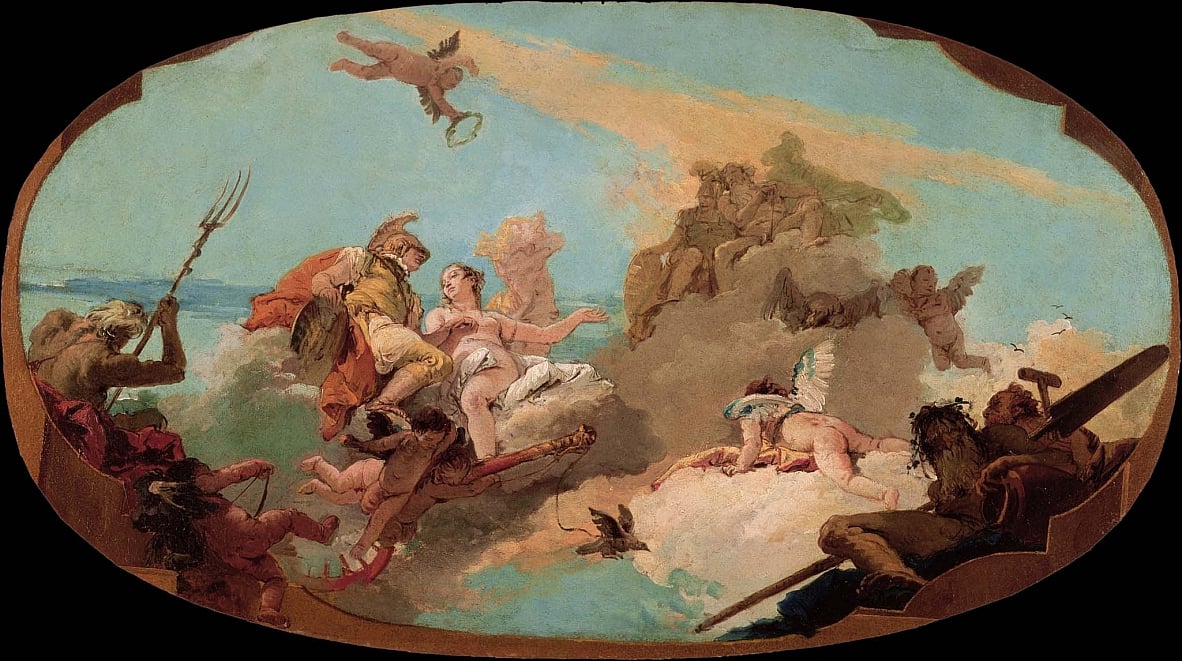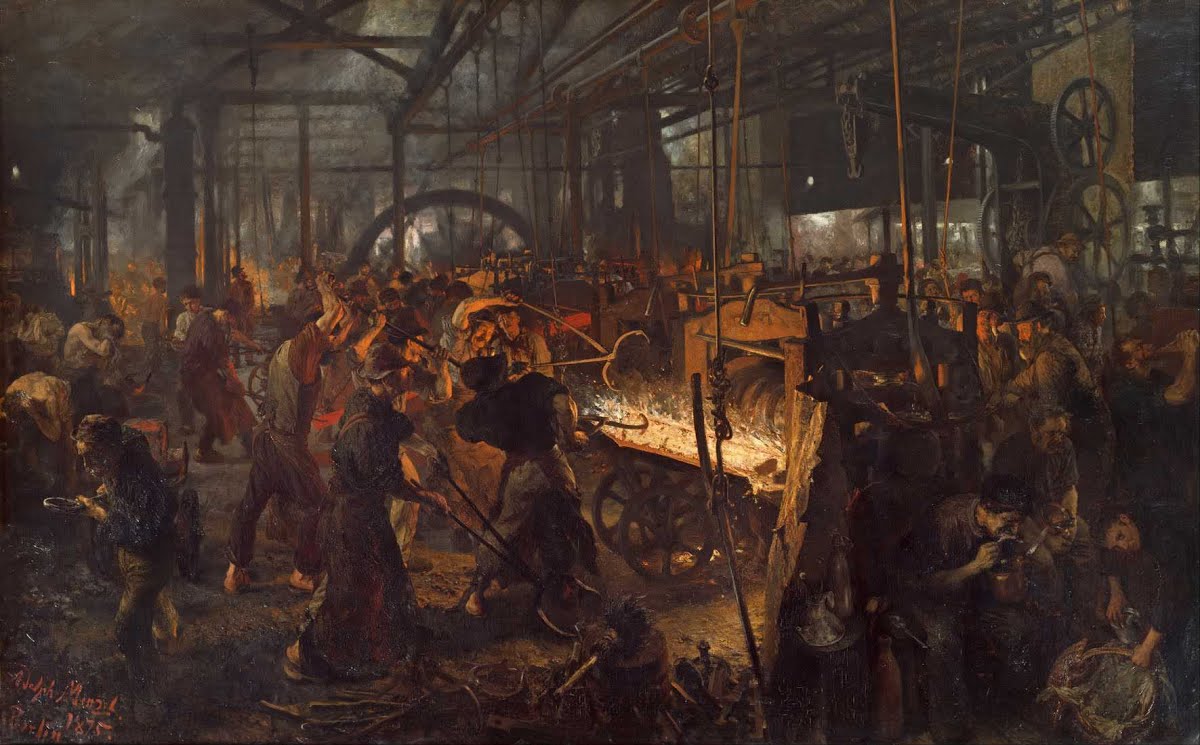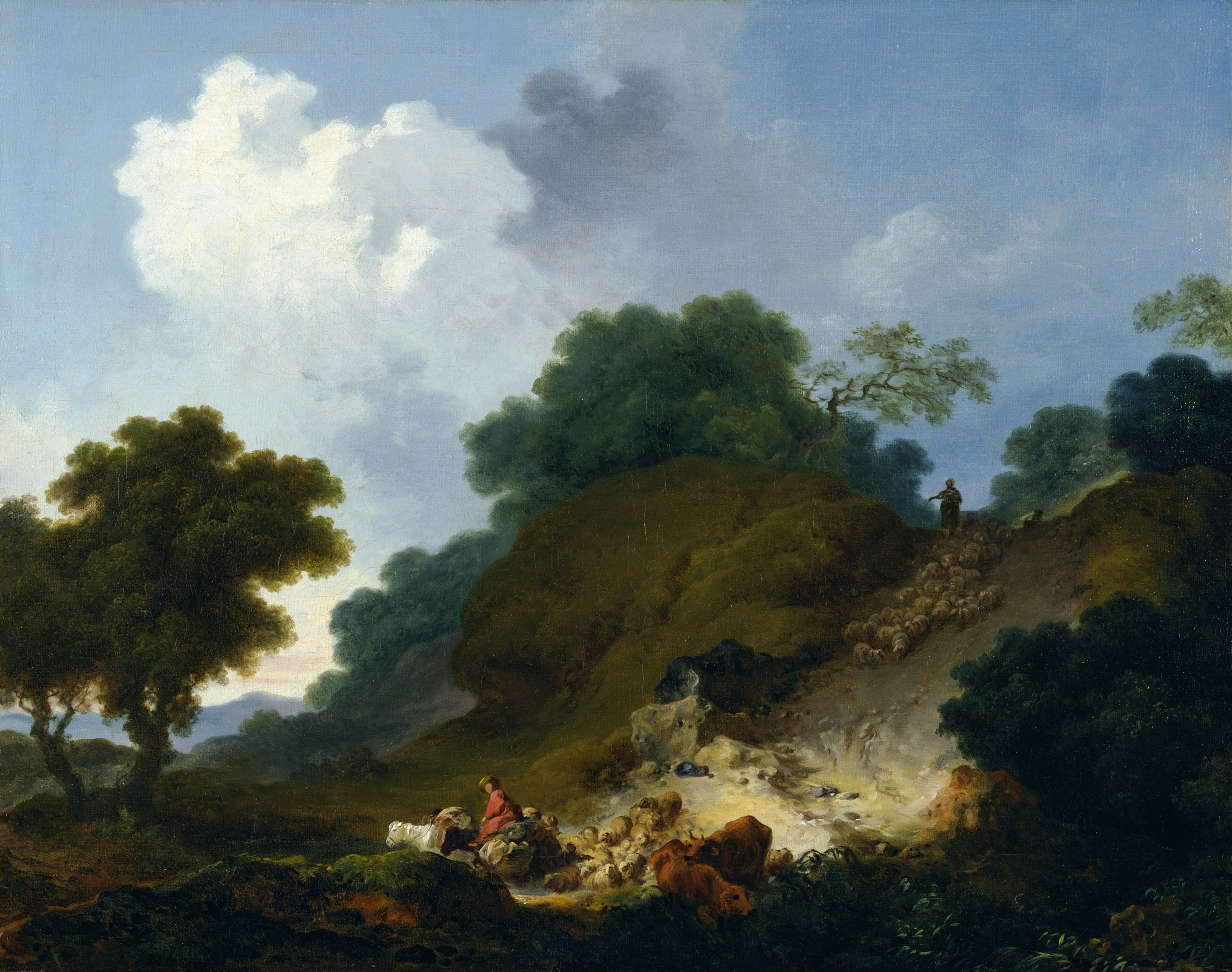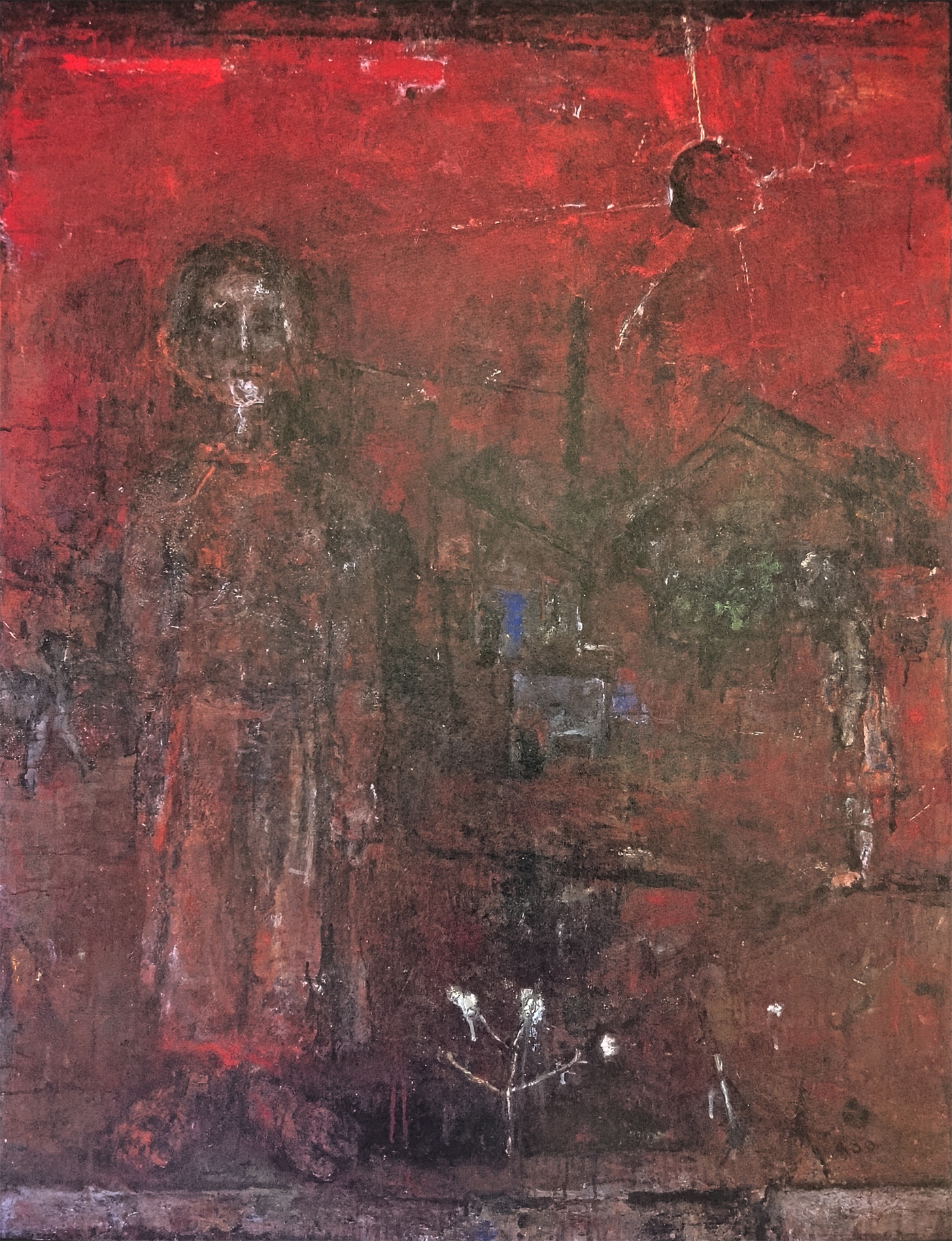

Giovanni Battista Tiepolo’s Apotheosis of Admiral Vettor Pisani is a small painting, I would not have been drawn to it over the much larger paintings that crowded around it in Tokyo’s National Museum of Western Art if not for that brilliant powder blue sky and the ridiculous oval frame. The frame here is a baroque monstrosity, but the sky is that of a painted coastal house softly peeling under a Mediterranean sun. It’s immediately lovely, but as I looked two triangular regions emerged and imposed a narrative on the scene. Knowing nothing about the scene but what the title told me, I saw an obvious triangular framing at the top placing the Admiral in the centre of an arrow pointing upwards, to heaven. The bottom triangle, bounded by the lower side of the first triangle and the sailors, was mysterious though. The sailors are situated in a lower region, in support of their leader but shrouded in darkness, as if those men were destined for hell. Are they mutineers? It seems unlikely. Perhaps they are enemies of the Admiral’s, defeated in a just conflict between good and evil. It seems more likely to me that they are just the sons of sailors, handling rope and oars and spears. It doesn’t matter whose side they’re on, in the scene the purpose of their bodies is to frame the composition of their Admiral’s apotheosis. They are not subjects within the scene, afforded some humanity by their rendering as tangible living people by the subtle gestures that render Pisani. They are objects, or perhaps less: an object. They are a formal device that frames a region of space, boxing in the possible wandering of the eye in order to tell us a story about their Great Admiral, who reclines in splendour as their shaded backs support His apotheosis.

Adolph von Menzel’s The Forge (A Modern Cyclops) is a more obviously tragic scene, a scene in which the unhappy condition of the lower class is not obfuscated by the endowment of divinity on a nearby aristocrat. The colours of The Forge are especially compelling. Since discovering the criticism of John Berger, whose Marxist model of aesthetics is based on the observation that an artwork as a material object is totally semantically neutral before we project our meaning onto it, it is most often the harmonics of the colour palette which has most often informed my process of projecting meaning. The harmonic character of colour is informed by the interrelation of colours used within the work itself, but it is also, prior to this interrelation, informed by an aesthetic standard internal to its observer which is partly socialised and partly indeterminate in its origin. Socialised, in that society ascribes meaning to colour in the same way that it ascribes meaning to arrangements of flesh on a human face, or the movement of celestial bodies. Indeterminate, in that my understanding of colour is informed by accidents of my biography. The place that frames my childhood: the occasionally dynamic English vortex of Turner and the more often industrial menace of a dreary East Midlands. The content of my experience: a life that in the living leaves behind a litter of images according to this or that sensory impression. Though I choose where exactly I can look, every available surface I have to choose from offers a torrent of barely sensible data. Emptiness is not an option.
So then: the colours of The Forge are especially compelling: they are a marriage of the delicate and the brutal, but why is this? I hazard a guess: the interrelation of browns and reds suggests a similar embodiment of spirit-as-substance that appears in the swirling clouds of flora in Jean-Honoré Fragonard. The whites and yellows of the flame and the subtle green in the ashen faces and feet of the workers are coded as vicious and painful, according to some unhappy experience. Whatever the reason, the marriage of delicacy and brutality seems somehow to befit the result of a 19th century painter, employing the techniques and conventions of an artform deeply linked with the pastoral aristocracy of Western Europe, to portray a scene as ghastly as the interior of a factory. It has much the same sort of internal contradiction as orientalist painting: a fascination with the other (the East, or the proletariat, both equally foreign to bourgeois sensibilities) that is appreciative and admiring but obviously patronising or superficial to a member of the othered caste of people that are its subject. This is of course an analysis made retroactively, a “way of seeing” that I have consciously and rationally applied to the subconscious and prerational wounding of the immediate impression.

In The Age of Extremes, historian Eric Hobsbawm reflects that “why brilliant fashion-designers, a notoriously non-analytic breed, sometimes succeed in anticipating the shape of things to come better than professional predictors, is one of the most obscure questions in history”. Indeed, the complete breakdown of the 19th century style Liberal Democracy that characterised the period between 1914 and 1945 was by a number of decades preceded by an aesthetic identity crisis among the culture of the rich. From the 1870s, the delicate artifice of beauty in the High Arts began to decay. Artists rushed towards innovation, away from the techniques and subjects enshrined in the canon, and increasingly (though this was certainly no rush until after the first World War) the notion of a High and Low divide in the arts began to dissolve as the deeper and more complete integration of the Capitalist market principle into the logic of European society created a mass market. As a generation of artists dove into the heady realm of theoretical and conceptual innovation that was the early avant-garde, and the mass market democratised what was left of the popular arts, the European upper classes were left in a cultural limbo.
When we evaluate this grand historical narrative from a distance, a century hence, we are liable to over-dramatise things. In this Healthline article, called “13 Habits Linked to a Long Life (Backed by Science)”, habit number eight is “prioritize your happiness”. Wow, what a good idea! “Feeling happy can significantly increase your longevity. In fact, happier individuals had a 3.7% reduction in early death over a 5-year study period.” This idiotic advice is telling us what already know: happy people are likely to live longer because happiness and longevity are both the results of material wealth—those who have it are are shielded from the sort of horrible material conditions (overwork, poor nutrition, monetary anxiety etc.) that cause the vast majority of all unhappiness in the first place.
When we look back on the art of the late 19th and early 20th century and read into it a rejection of Liberal Democratic principles, or a hostility to the culture of the bourgeoisie, or a critique of Imperialism, we are not seeing artists display an uncanny ability to anticipate the rise of fascism in the West and communism in the East. We are reading, and reading can be done in many ways. The sentiment in the artists that produced those works is the same sentiment that existed in the psyche of those rulers that produced “the most terrible century in Western history” (Isaiah Berlin). Outside of that period, we look back, and by the very nature of the directionality of history, read causation and a tendentious prediction into the works of the age. This is true more than ever, in a time in which the restructuring of social relations on the basis of the individual produces a bizarre situation: a generation with unparalleled access to information about the past, but very little sense of actually belonging to the continuity of history.
Battling in 14th century Europe, Admiral Pisano’s naval exploits were probably some of the last to not be dominated by gunpowder—they were fought as they had been fought for ages: with blades and arrows and muscle. By 1875, the time of Menzel’s scene, even our domestic industry took on an aspect of the armaggeddon hitherto unseen in the idyllic rough and tumble of Pisani’s time. In an 1865 report, an Irish factory surgeon described the condition in his native Downpatrick: “The serious accidents at the scutching mills are of the most fearful nature. In many cases a quarter of the body is torn from the trunk, and either involves death, or a future of wretched incapacity and suffering.”.
A 21st century observer is sadly accustomed to images of trench warfare and mushroom clouds and napalm, and to the scenes of hellfire that consumed generation after generation of poor people in the process of building our world. One might then advance the thesis: a hierarchy of violence emerges in the scenes of turmoil we find in our paintings, according to their proximity to the increasing violence in our world. As with many misunderstandings in aesthetics, this seems to me to be a mistake in applying a hierarchy to incommensurable magnitudes. In fact no such hierarchy is possible, as the depictions of violence differ in an essential character that eludes comparisons of magnitude. This or that painting cannot depict a greater violence than any other painting. We as observers read that violence into the work, and it is the violence that we have internalised in our psyches—violence that has been socialised by never ending war, and violence which makes its impression unique by the indeterminate stream of images that delivers it into our subconscious.
Representation fails by many orders of magnitude. Reading these works as requiems for the furnace of catastrophe is as absurd as reading the apotheosis of Admiral Vettor Pisani as an elegy to the divinity of martial excellence. There is evidence in these works of attitudes, we can use them to explore ideas about hegemony and hierarchy, but they do not in any way represent the madness of the Gorgon, the 20th century death machine. What art possibly captures some essential character of Auschwitz, or of Hiroshima? There are no pictures of suffering. There is suffering, and there are pictures.
